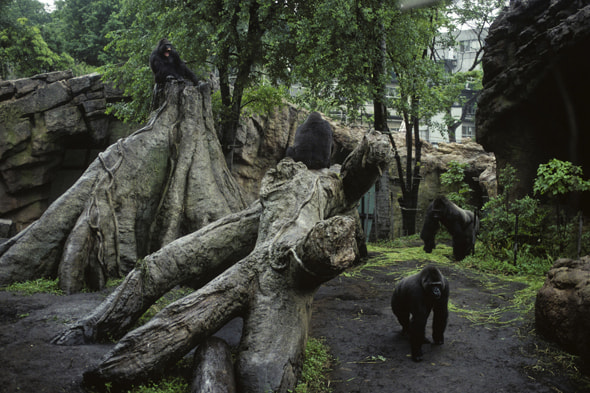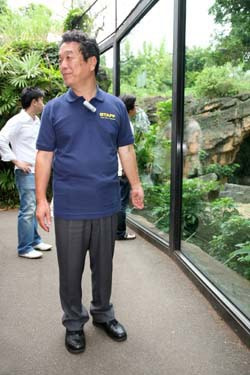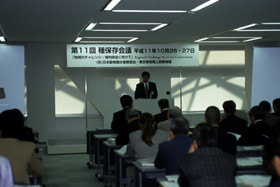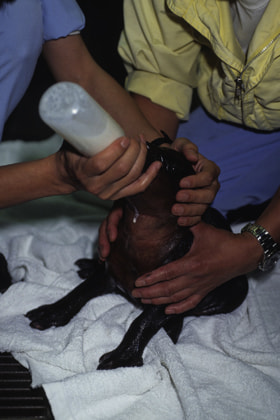
Overall view of "woods where gorillas live"

Q: What animal requires the greatest deal of care?
Komiya: It is the giant panda of which house needs to be air-conditioned. We will be in trouble if animals fall sick, so animal handlers stand for the overcooled condition in summer.
Q: What about an animal hospital and feed preparation room?
There are four full-time veterinarians. Unlike dealing with human beings, veterinarians should inspect all parts of an animal's body, including eyes and teeth. In the feed preparation room, each animal's feed is processed by a person who is in charge of that animal. Some feed for alien species cannot be obtained. Ramies (sort of nuts), a staple diet for aye-ayes native to the Island of Madagascar, cannot be obtained, so we substitute macadamia nuts for ramies. Bamboos, a staple diet for giant pandas, grow in Japan, so feed for pandas is less expensive than that for koalas. Eucalyptuses, a staple diet for koalas, do not grow in Japan, so we made a farm and cultivated eucalyptuses.
Q: Have you often donated bodies of animals which died in the zoo to the National Museum of Nature and Science and other facilities?
It is helpful that the neighboring National Museum of Nature and Science can preserve dead animals in good conditions as stuffed specimens. In the museum, there is also a complete skeleton of an unnamed female elephant that was first kept in the zoo.
Q: Was the zoo affected by the Great East Japan Earthquake?
We took otters from an aquarium called Aquamarine Fukushima that was damaged by the earthquake. Kamogawa She World took care of walruses and Steller's sea lions, and every zoo bore its share of taking care of evacuated animals. Also, feed for animals could not be delivered to Sendai for some time after the earthquake, so we made arrangements for the feed to be sent to Sendai. After the Great Hanshin and Awaji Earthquake occurred, Kobe Oji Zoo was closed for a long time, so zoos in the Kinki Region cooperated to take care of evacuated animals and transported their feed.
(continued in the upper right column)

The 11th Species Survival Committee of Japan (SSCJ) Meeting, sponsored by the Japan Association of Zoos and Aquariums and the Ueno Zoological Gardens, was held in 1999. The meeting has been held at each member zoo or aquarium in turn.
Q: What about the monkey mountain in the Ueno Zoo?
When we built the monkey mountain in the zoo, plasterers went to see monkeys on Mt. Takago in the Boso Peninsula. In the United States, casts of rocky tracts, such as the Grand Canyon, were taken, and patents for them were taken out. Those casts have served as models of monkey mountains in zoos all around the world. As a result, there is a strange situation where monkeys live in the Grand Canyon though it is a zoo in Japan. It can be said that the monkey mountain in the Ueno Zoo is Japanese scenery.
Although a display space of the "woods where gorillas and tigers live" is surrounded by imitation rocks, gorillas' original habitat is jungles, so wall greening is now underway. The wall greening is expected to produce an effect that lowers temperature.
Q: Are northern and tropical animals segregated?
Komiya: In the Ueno Zoo, it is difficult to completely segregate those animals due to space constraints and environmental issues. In the Tama Zoological Park, its grounds are divided, and animals are kept by their inhabiting regions. However, some students at Tokyo University of the Arts said that the Tama Zoological Park is too spacious, so they can draw landscapes with animals, but cannot draw porcupine quills because the porcupine is too far away. The smallness and nearness of the Ueno Zoo might be attractive for those who want to see total pictures of animals, from tips of their noses to tails. (continued in the next page)

The first birth of a pygmy hippopotamus in 35 years (1999)











